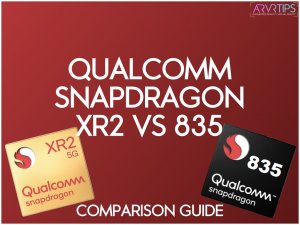In this guide, we compare the Qualcomm Snapdragon XR2 vs 835 CPUs in order to determine how much of an upgrade the Oculus Quest 2 is over the original!
If you’re a virtual reality enthusiast looking for the differences or similarities between the XR2 and Snapdragon 835, then you are in the right place.
Click here to order the Oculus Quest 2 from the official website.
RELATED: Go and check out our Oculus Quest 2 vs Quest 1 guide for a full buyer’s guide on the two headsets.
Before we compare the SNapdragon XR2 vs 835, lets break down each chip at a high level.
What is the Qualcomm Snapdragon 835?
The Qualcomm Snapdragon 835 is a high-end system on a chip (SoC) used to power the original Oculus Quest. It was released in early 2017 and used on the Quest in 2019. Multiple Android phones used the 835 as its chip in 2017.
The Snapdragon 835 was one of the first processors that is manufactured using 10 nm. The SD835 is the successor to the Snapdragon 821. It has 8 cores, 8 threads, and a turbo frequency of 2.5GHz.
The SoC means that it comes with the CPU, graphics processor, Wi-Fi and 4G modem, sound hardware and sensor hubs. SoC’s were created to keep components packed tightly inside of a mobile phone, which is limited in space. Desktop computers have separate CPUs and GPUs and other components.

What is the Qualcomm Snapdragon XR2?
The Snapdragon XR2 is specifically built for standalone VR and AR headsets. It was unveiled by Qualcomm at the end of 2019, who then partnered with Oculus to customize its capabilities. The XR2 is used to power the new Oculus Quest 2.
Like the 835, the XR2 has a total of 8 cores, 8 threads, and a turbo frequency of 2.5 GHz. The XR is an entire system built with the Snapdragon 865 CPU, which was announced at the same time. Oculus claims that the XR2 in the Quest 2 has big improvement over the 835 in the Quest 1, including:
- 46% more CPU power
- 33% more GPU power
- Improved I/O performance
But that doesn’t tell the entire story about this chip.
Being over two years newer, the XR2 definitely has more power packed into its SoC, but how much?

Snapdragon XR2 vs 865
Before we compare the Snapdragon XR2 vs 835 for virtual reality, we want to compare the Snapdragon XR2 vs 865. The XR2 is a platform that is powered by the 865 CPU. However, the XR2 contains a number of improvements specifically for VR:
- Support for 7 concurrent inside-out tracking cameras (note that the Oculus Quest 1 and 2 each only have 4 cameras today)
- 5G support to power new artificial intelligence possibilities
- Support for additional virtual reality sensors and external devices
- Low-latency camera passthrough features made specifically for mixed reality (MR)
- Support for specific VR features like foveated rendering, eye tracking and enhanced variable rate shading, while minimizing power consumption
Simply put, the 865 is a mobile phone chip and the XR2 is a full SoC built for mixed reality. Now that we’ve compared the Snapdragon XR2 vs 865, let’s go back to comparing the XR2 and 835 in the new Oculus Quest!
Snapdragon XR2 vs 835
GeekBench – Single-core and Multi-core
GeekBench is a processor benchmarking program. Like other CPU benchmarks, GeekBench runs a series of tests on a processor and times how long the processor takes to complete the tasks. The quicker the CPU completes the tests, the higher the GeekBench score.
For some people, the GeekBench is the number one test to find out the quality of the CPU. It mimics real world tests of the device.
Since the Oculus Quest 2 is not officially out yet, we have to use an equivalent GeekBench score. The HTC Vive Focus VR headset uses the same XR2 chip and is the closest comparison.
Overall Score
Below, you can see the GeekBench results between the Oculus Quest (835) and HTC Vive Focus (XR2).

As you can see, the Snapdragon XR performs 3.5 times better on single-core tasks and 4.6 times better on multi-core tasks. At face value, that is a pretty huge improvement.
But the overall score doesn’t always tell the full story. Let’s have a look at how individual tests performed between the Snapdragon XR2 vs 835. Along the way, we’ll point out which tests are important for virtual reality gaming.
Single-Core Tests

The image compression test practices compressing and decompressing images in different formats, a common function of a CPU. The Snapdragon XR2 is 3.3 times quicker at compressing images, 4.46 MB/s vs 1.35 MB/s.
The navigation test computes driving directions between a sequence of destinations using Dijkstra’s algorithm. Similar techniques are used to compute paths in games, to route computer network traffic, and to route driving directions. In this test between the XR2 vs 835, the XR2 is 2.82 times faster.
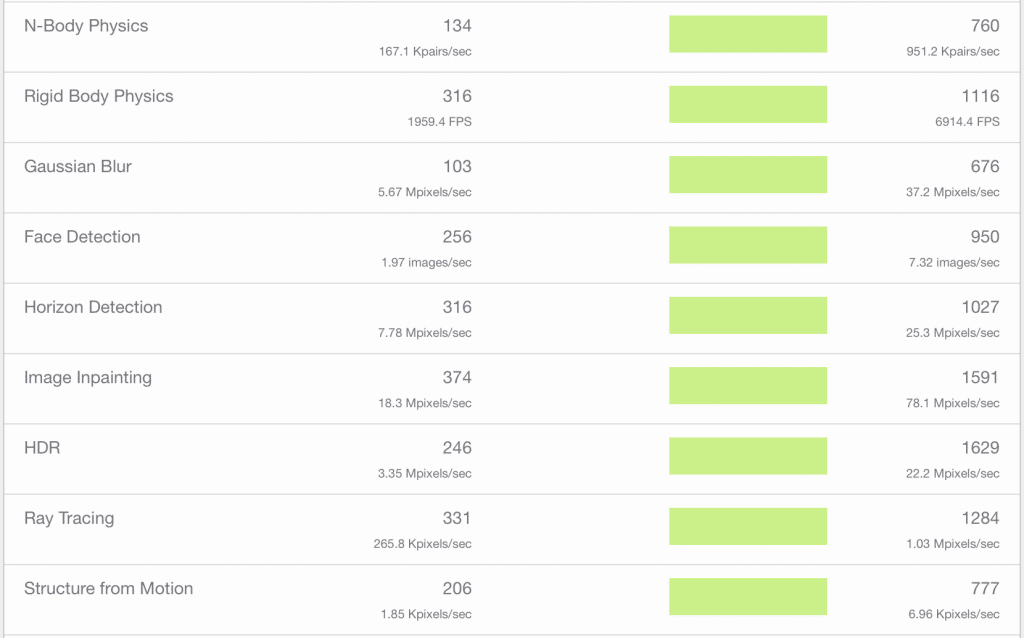
Have you ever played a Quest game that gets harder and harder and you notice lag in the graphics as more and more objects are on the screen? The physics tests practice simulating different collisions and interactions and is a test of how well the system can multi-task. Based on the numbers above, the Oculus Quest 2 will be between 3 and 5 times more efficient at handling physics and collissions.
The HDR test takes regular images and converts them to high dynamic range, which is a common tactic used to increase the graphics in a legacy game. The new XR2 chip kills it in this area, over 6.6 times faster than the 835.
Multi-Core Tests

Multi-core tests use all of the cores on the CPU chip to perform all of the same calculations as before. In general, the cores on the GPU work together to multi-task and accomplish tasks quickly together. Across the board, the Snapdragon XR2 vs 835 is no comparison. The new chip is up to 6 times faster.
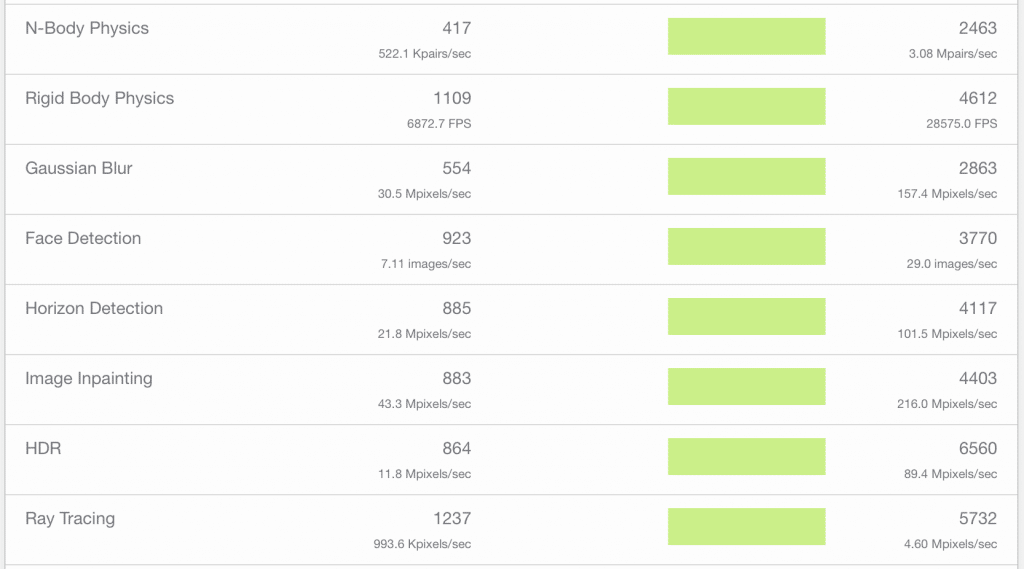
The HDR test is the biggest win on the new CPU SoC. The XR2 is 7.6 times better at up-scaling graphics.
From a GeekBench perspective, fans should be really excited about the potential power in the Oculus Quest 2. We’ll be able to confirm these numbers as soon as the Quest 2 is officially released. One more thing to add is that the tests above with the HTC Vive Focus are with 4 GB or RAM. The Quest 2 comes with 6 GB of RAM, which should help things even more!
Click here to learn more about the GeekBench tests.
If you aren’t convinced, let’s look at some of the individual specs of the Snapdragon XR2 vs 835.
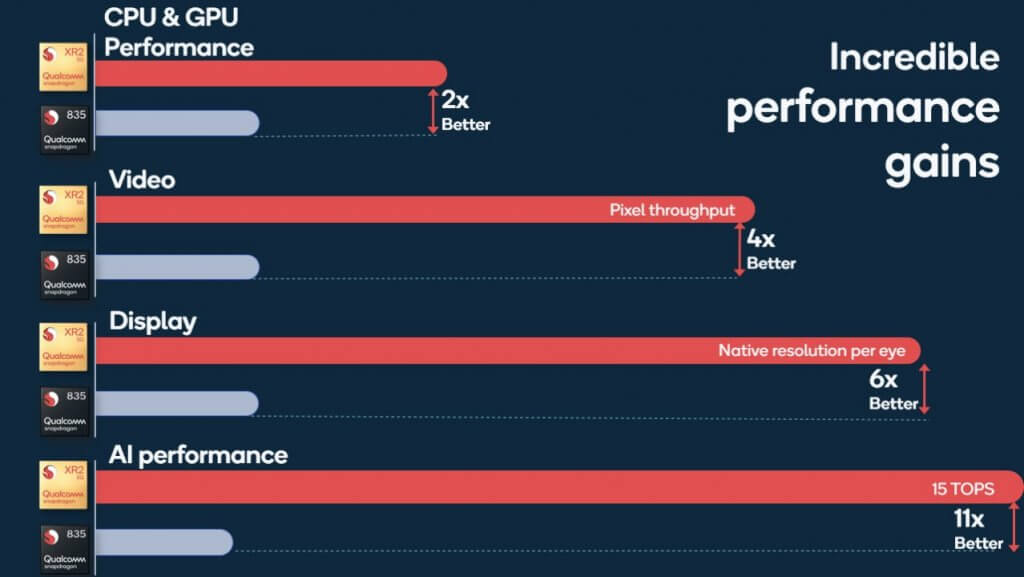
CPU Performance
The Snapdragon XR2 unlocks maximum power and performance for VR gaming. It is built for speed and enhanced performance. In terms of CPU performance, it deliver 15% faster graphics rendering and uplift than the Snapdragon 835.
The biggest highlight with the XR2 is that the primary CPU core can achieve up to 3.1 GHz clock speed. This over-clocking should allow the chip to have some serious power.
GPU Performance
The Adreno 650 GPU in the XR2 features a number of improvements, such as a faster trilinear filtering and GPU compute. It also boasts a 25 percent gain to 3D rendering performance over the 530 in the 835 SoC, which is a notable boost.
The Adreno 530 in the 835 is notably slower than the graphics card in the XR2.
Both chips support the DirectX 12, OpenGL ES 3.2, OpenCL 2.0, & Vulkan graphics APIs.
XR2 vs 835, the main CPU and GPU both offer nice upgrades in the same size of package.
Display
In terms of display technology, the XR2 vs 835 have the exact same specs. Both cards can support 4K at 60Hz and QHD+ resolution at 144Hz.
HDR10, HDR10+, up to 10-bit color depth and Rec2020 color gamut are supported as well.
In theory, this means that both chips can power the same display. However, remember that the Oculus Quest 2 contains a single-panel LCD screen that has 50% more pixels than the last generation. This means that the Snapdragon will be able to utilize more features on the new headset than before.
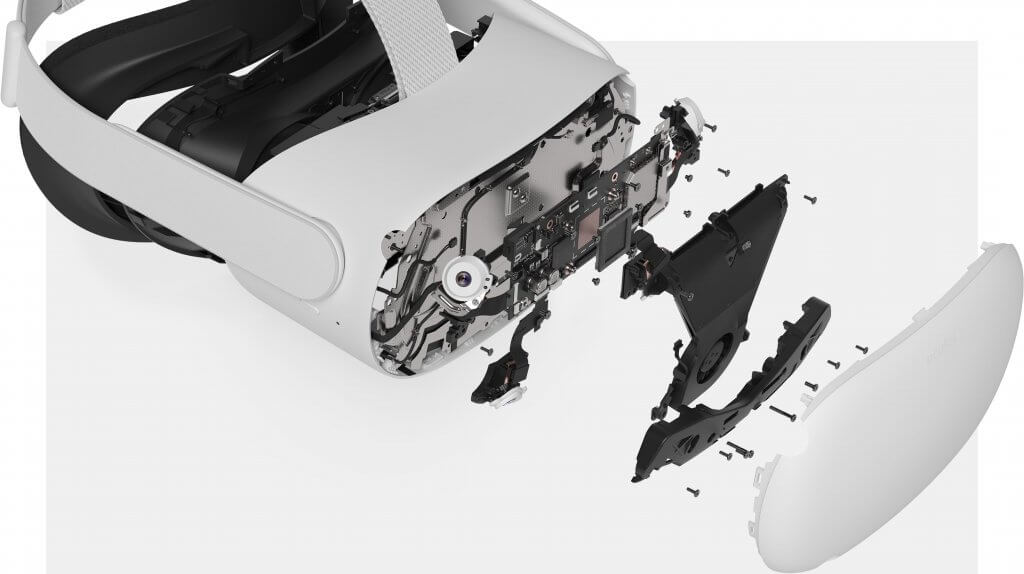
AI Performance
Artificial intelligence is the cornerstone of Qualcomm’s Snapdragon XR2 chipset. Qualcomm claims 11x improvement in the AI performance of the XR2 vs 835. This improvement comes from the addition of more arithmetic logic units (ALUs) on the chip, which handle high-tech processing.
However, in some tasks, such as recording high-resolution video and rendering 3D games, the 835 is up to 30% more efficient.
Cores
Processor cores are individual processing units within the chipset. The processor core receives instructions from a single computing task and work with the clock speed to quickly process information. It also temporarily store the information in the Random Access Memory.
The Snapdragon 835 contains the following cores:
- 4 Kryo 280 Gold (ARM Cortex-A73 based)
- 4 Kryo 280 Silver (ARM Cortex-A53 based)
The new Snapdragon XR2 contains the following corest:
- 1 Kryo 585 Prime (ARM Cortex-A77 based)
- 1 Kryo 585 Gold
- 2 Kryo 585 Silver
Battery life
One of the aims of the Snapdragon XR2 is to greatly improve energy efficiency, allowing for sustained peak performance and longer lasting battery life.
The XR2 booasts of an extra 20% worth of battery life, as against what users will get with the Snapdragon 835.
However, it is remained to be seen if Oculus has given the extra battery life to the player. And early reviews on the new VR headset show the same or slightly less battery life than the first generation. This is most likely due to the extra display resolution and refresh rate.
What do you think about the XR2 vs 835. Hopefully this paints a better picture about the specs in the new Oculus Quest 2 verses the original Quest.
Comment down below and let us know what you think!

